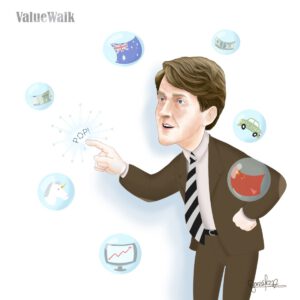By robbennett. Originally published at ValueWalk.

We’re trapped.
Q4 2021 hedge fund letters, conferences and more
Interest rates are low. Inflation is high. If interest rates are increased to to reflect today’s inflation rate, stock prices will come crashing down. Which will cause trillions of dollars of spending power to disappear from the economy. Which will cause the entire economy to contract. Hundreds of thousands of businesses will go under. Millions of workers will lose their jobs.
The Root Cause Of Low Interest Rates
The root cause?
In my view, it’s today’s CAPE value (37).
These things are all connected. The inflation rate doesn’t really make sense. Today’s interest rates don’t really make sense. But the core irrational thing is the CAPE value. We like high stock prices. They provide the illusion of wealth. So we will do just about anything to keep high stock prices high. If it takes pushing interest rates down to absurd lows, we will do that.
But these things can’t last forever. Low interest rates keep stock prices high temporarily (by making non-stock asset classes less appealing relative to stocks). But in the long run low interest rates increase the risk of a price crash. When stock prices are depending on low interest rates to maintain their height, that’s one more thing that could cause a collapse. Stock prices can always fall because of bad economic news or because investors lose confidence in the bull market. When interest rates are low, they can fall because of a rise in interest rates as well.
And how about that crazy CAPE value of 37? That’s connected to earlier crazy CAPE values. Shiller warned in 1996 that investors would eventually pay a price if they did not move out of stocks in response to the high CAPE value that applied at that time (25). Prices did not fall until 2008. Then they fell hard. But they only remained at reasonable levels for a brief time. In late 2009, prices returned to the lofty levels that had applied prior to the 2008 crash and they have remained there ever since.
We have missed out on so many chances to pull stock prices down. We could have done it in 1996, when Shiller advanced his warning. We could have done it in 2000, when tech stocks crashed but the broader market retained most of its value.We could have locked in the CAPE value of 17 when prices crashed in 2008 instead of letting the CAPE zoom to the sky again in late 2009. We could have brought prices down at any time from 2009 until today instead of letting them drift all the way to a CAPE value of 37.
The Efficient Market Theory
Now we are trapped. With inflation where it is, interest rates need to be increased, But an increase in interest rates could cause the entire house of cards to tumble. It’s not interest rates or inflation that are the real problems. The driver is the near universal tolerance of high stock prices. Let stock prices rise to the levels where they have resided since 1996 and you are going to see economic disruptions. There is no getting around it. Craziness never remains stationed in one place. Unless stamped out when discovered, it spreads.
The first craziness was the Efficient Market Theory. This academic construct posits that investors make rational choices. When economic prospects improve, they invest in the companies that benefit from those developments, pushing stock prices up. When economic prospects diminish, they do the opposite, The stock price is always close to what it should be. So stock prices cannot be predicted. Market timing isn’t required and probably does not even work.
The reality (according to me) is that investors are at times highly emotional, pushing stock prices up for no reason except that they want their stock portfolio to show bigger numbers. The reality principle ensures that the irrational exuberance cannot remain in place indefinitely. As irrational as they are, investors possess common sense and worry that price bubbles will pop. So they pressure policymakers to keep prices high by taking actions such as lowering interest rates. Until one day we find ourselves in a trap in which no policy choice looks appealing.
I hate this stuff. All economic decision-making would become less foggy if we lived in a world in which the CAPE value was never permitted to get much above its fair-value level of 17. We don’t need to elect a new president to make that happen or to enact new laws. We just need to begin purchasing stocks in a more sensible way, in the way in which we purchase all other goods and services – with price in mind at all times. Price matters as much when buying stocks as it does when buying anything else offered for sale in this consumer wonderland of ours.
The way to practice price discipline when purchasing stocks is through market timing. Market timing is the answer.
Rob’s bio is here.
Sign up for ValueWalk’s free newsletter here.



